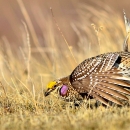About Us
Sustained high water levels have drastically changed the character of the Refuge over the past 20 years. Previously, the Refuge consisted of approximately 6,000 acres of shallow wetlands and 6,000 acres of grasslands. The shallow wetlands provided quality habitat for waterfowl and a variety of waterbirds, while uplands provided nesting cover. The Refuge was also an important for ducks and geese when they molted their feathers. Due to significant rising water levels on the interconnected Devils Lake, the Refuge is now almost entirely open water with less than 500 acres of upland habitat. That said, Lake Alice National Wildlife Refuge still provides habitat for many species of migrating birds as they make their journey north and south each year.
Our Mission
Each unit of the National Wildlife Refuge System is established to serve a statutory purpose that targets the conservation of native species dependent on its lands and waters. All activities on those acres are reviewed for compatibility with this statutory purpose.
The mission of the National Wildlife Refuge System is to administer a national network of lands and waters for the conservation, management and, where appropriate, restoration of the fish, wildlife and plant resources and their habitats within the United States for the benefit of present and future generations of Americans.
Other Facilities in this Complex
Lake Alice National Wildlife Refuge is part of the Eastern North Dakota Complex. A National Wildlife Refuge Complex is an administrative grouping of two or more refuges, wetland management districts or other refuge conservation areas that are primarily managed from a central office location. Refuges are grouped into a complex structure structure
Something temporarily or permanently constructed, built, or placed; and constructed of natural or manufactured parts including, but not limited to, a building, shed, cabin, porch, bridge, walkway, stair steps, sign, landing, platform, dock, rack, fence, telecommunication device, antennae, fish cleaning table, satellite dish/mount, or well head.
Learn more about structure because they occur in a similar ecological region, such as a watershed or specific habitat type, and have a related purpose and management needs. Typically, a project leader or complex manager oversees the general management of all refuges within the complex and refuge managers are responsible for operations at specific refuges or wetland management districts. Support staff may include administrative personnel, law enforcement, refuge manager, biological, and fire staff that are centrally located and support all stations within the complex.








